Wenhaston was the next stop, there’s very little trace of this station even though it was a much pictured one. The line crossed the River Blyth once again about half a mile west of Wenhaston station. Here too was the line’s one and only important road level crossing although there were some other minor crossings along the line.
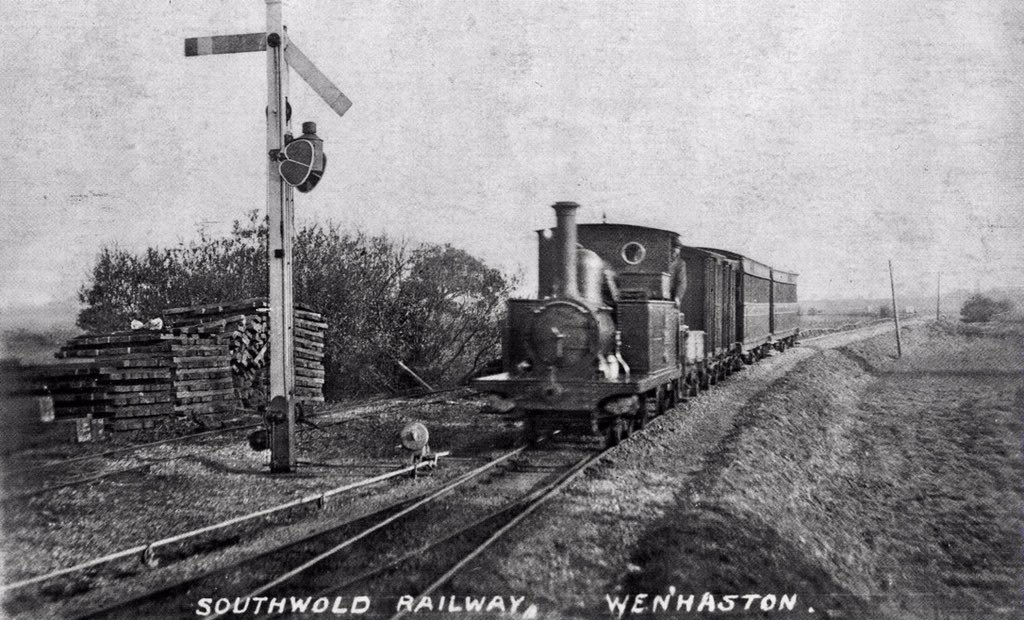
Lovely view of the signals at Wenhaston! All the Southwold’s signals were of the simple slotted type. Source: Twitter.
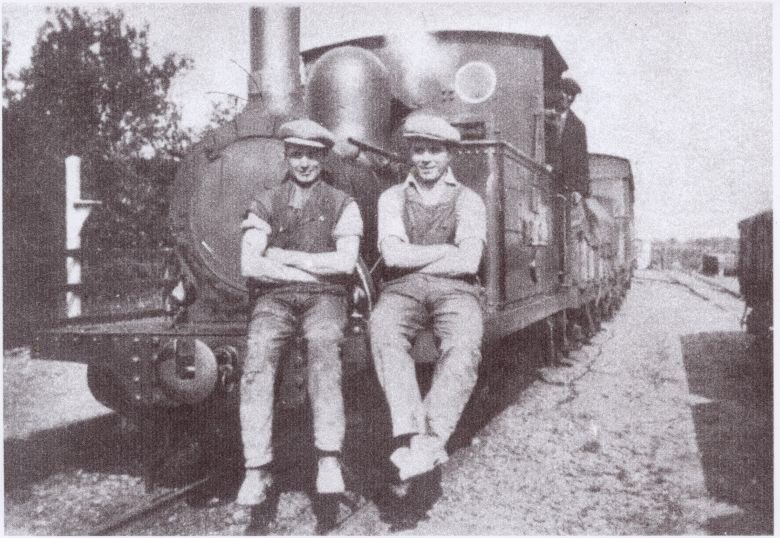
Two lorry drivers from Beccles posing on the locomotive for the camera at Wenhaston. Source: Twitter.
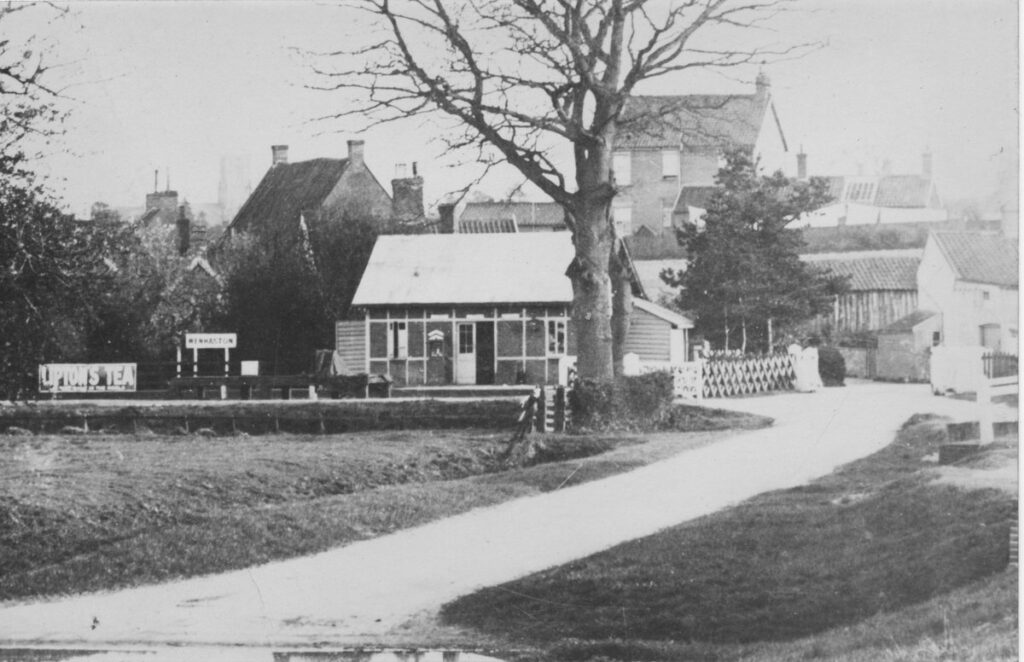
Wenhaston station prior to 1906. Source: Twitter.

This photograph of Wenhaston station is one of the most notable – being one of the railway’s official pictures. That alone explains why its of such high quality. The engine is of course No.1 Southwold. After the line had closed, this official picture was used as the subject for a real photo postcard, evoking reminders of the erstwhile railway. It explains why those words on the card say ‘Southwold Railway train. Sep 1879 – April 1929.’
As the line climbed towards Halesworth the more hilly terrain meant overbridges were necessary (although there was a small one in the Heronry.) In fact the line’s climb from Blythburgh (12 feet above sea level) was in the order of sixty feet and with the line’s summit at Halesworth station at roughly around the 72 foot mark.
Rather curiously Corner House bridge is never mentioned in the annals of the Southwold Railway ‘s history nor by most authorities on the railway – yet this bridge and its adjacent cutting can be seen on Google Streets. Here’s a tweet however from the HalesworthNGRS that shows it.

Descending Holton embankment no.4 Wenhaston is seen happily chugging its way to Southwold sometime in 1928. Source: Twitter.
The section westwards from Wenhaston was more steeply graded and there were a number of embankments and minor cuttings to keep the line’s gradients as even as they could be. The final bit into Halesworth was on a 1 in 66 gradient – which caused problems sometimes when shunting operations were being undertaken.
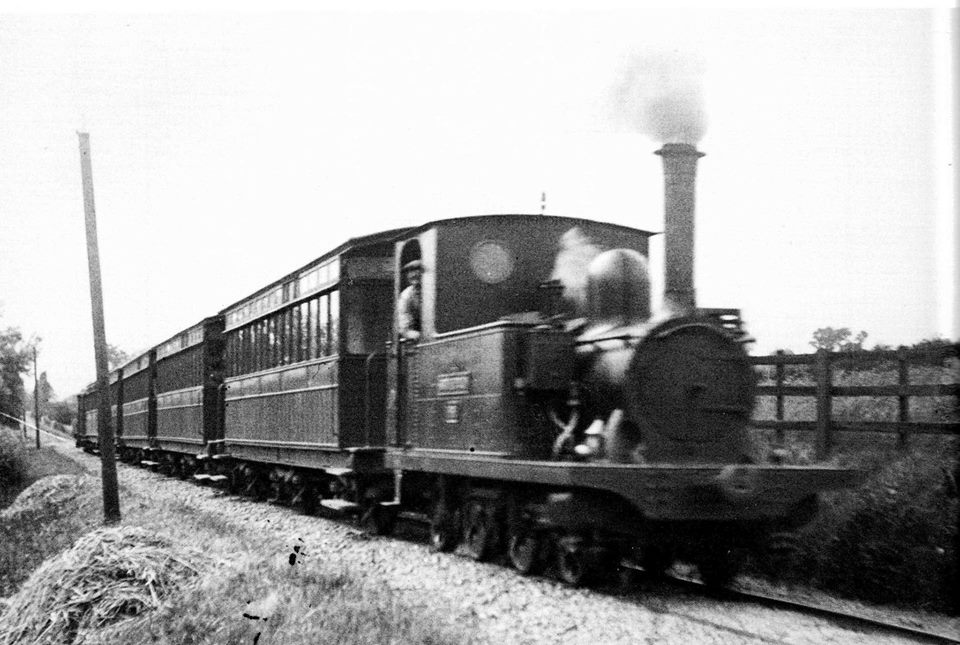
No.1 Southwold heading along the hilly section of line to the west of Holton, having just left Halesworth. Source: Internet Archive.
Although the larger of the overbridges along this section across the B1123 has gone (see tweet news article) the one a littler further east at Birds Folly is still extant. There is a bit of track on top of the bridge itself however this was laid down in 2000. Just beyond here the line meets the Great Eastern Railway and this final section into Halesworth is by all means the line’s summit. For a view looking from beneath the Great Eastern line itself towards Bird’s Folly bridge here’s this nice perspective from Google Streets.
The railway’s other engine shed was just here. There was a siding too which served the gravel pits nearby. Engine no.3 Blyth languished in its shed for many years after the railway closed.
The bridge across the B1123 at Halesworth with its huge advert for the railway was also extant for many years. It was finally removed in 1962 as this Twitter post from the Halesworth & Southwold NGRS details.
Our mission is to #PutHalesworthfirst
— Halesworth to Southwold Narrow Gauge Railway (@Halesworth2Swd) June 4, 2018
The #narrowgauge railway which meandered through the #Blyth Valley started at Halesworth and linked there with main line trains at the adjoining standard gauge station. pic.twitter.com/w9KJ9t0iNv
The derelict railway at Halesworth, probably 1942. Source: Twitter.
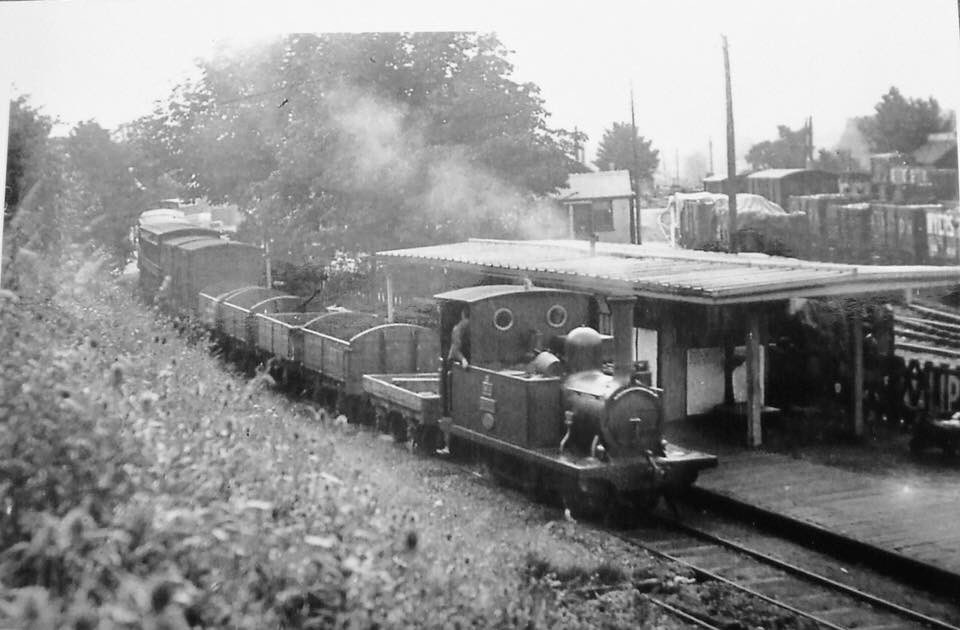
No.3 Blyth is seen arriving at Halesworth in September 1910. Source: Twitter.

In the early days of the railway, this is a picture of no.3 Blyth at Halesworth in charge of a Southwold train. Source: Facebook.
The final Southwold timetable can be seen from this entry in the January edition of my ABC Rail Guide for 1929. Generally it was four hours or more journey time from Liverpool Street. The times of the services barely changed over the years except the later train 7.15pm ex Southwold and 8.00 ex Halesworth no longer ran.

The Southwold Railway closes just short of its half-century:

Inevitably the less happier days arrived… the final week of the railway. Here is Southwold’s station staff with A. B. Jenkins (at right) with his cine camera ready to record the railway’s last days of existence. Some rued the the fact the line shut five months short of its 50th anniversary. The end came very suddenly – the most notice any of the staff had was just two weeks.
These were the years of the depression and its perhaps no surprise the railway suddenly threw the towel in. The previous two summers, 1927 and 1928, had been dismal in terms of passenger loadings. The railway did not even bother with any closure notices. It was very late in the day that newspapers got wind of what was happening.
The last passenger train was in the evening of April 11th 1929, doing the usual round trip from Southwold to Halesworth and back. This would have been the 5.23 from Southwold and the 6.41 from Halesworth. The last train had about 150 passengers on it. The return from Halesworth was considerably delayed when it was found none of the lamps in the train’s carriages had any wicks! This meant the train could not proceed until new wicks had been sourced and the carriages lit up for that very last trip to the coast. Many well-wishers waited in the cold and dark at Southwold in order to pay their respects to the late running final passenger train ever to run into the town’s station.

Captured on film – huge numbers turned out to bid farewell to the last train ever to leave Southwold. This video is at the East Anglian Film Archives but can also be seen on You Tube.

Southwold’s Station Master, Mr VC Girling, shakes hands with, John Stannard, the driver of No.3 Blyth, on the very last day of operation, April 11th 1929. Source: Twitter.
Yes that was the last passenger train – but not quite the final train on the line. Like a lot of the narrow gauge railways in these isles which had officially closed down (but still had matters needing attending to) the Southwold too soldered on just that little a bit longer in order to wind up its affairs properly.
No.4 Wenhaston was employed for a further week and half to help sort final goods consignments including coal supplies for customers and clear all outstanding stock from the stations and sidings. Once this had been done, all of the railway’s rolling stock was moved to Halesworth. The job was completed on the morning of Saturday 20th April 1929 with Wenhaston returning to Southwold engine shed and everything being locked up for the last time.
Two of the railway’s staff took up new careers managing garages servicing the railway’s successors – those new fangled cars and motor buses – whilst the engine crews found work at the local mills. The older men found little or no work, this being the years of the depression and employment wasn’t easy to find.
Part three – the railway’s decades of dereliction and decay.
Southwold Railway Posts:
